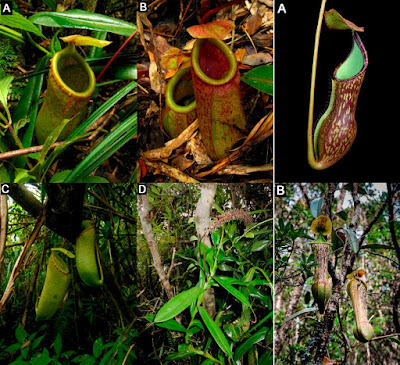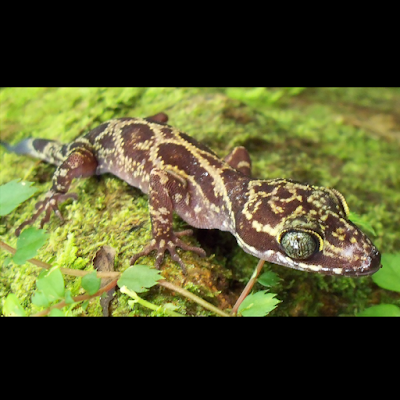[Most Recent Entries] [Calendar View]
Tuesday, May 10th, 2016
| Time | Event | ||
| 9:22a | [Botany • 2016] Nepenthes aenigma & N. justinae • Two New Nepenthes Species from the Philippines and an Emended Description of Nepenthes ramos
Abstract With 50 species of the genus Nepenthes L. currently described from the Philippines, it is without doubt that the country, along with the islands of Sumatra (Indonesia) and Borneo (Indonesia, Malaysia, Brunei), should be considered the center of diversity of the genus. In this work, we describe two new species. One species, Nepenthes aenigma sp. nov., is from Ilocos Norte province on Luzon Island and has the — for Nepenthes — unusual ecological preference to grow in dense vegetation in deep shade. The other new species is from Mount Hamiguitan in Davao Oriental province on Mindanao Island. With this new entry, Mount Hamiguitan is now home to four endemic species (N. peltata, N. micramphora, N. hamiguitanensis, N. justinae sp. nov.). Furthermore, we provide an emended description of N. ramos based on field data. Nepenthes kurata is synonymized here with N. ramos. Keywords: carnivorous pitcher plants; Nepenthes; Ilocos Norte; Mount Hamiguitan; Philippines Nepenthes aenigma Nuytemans, W. Suarez, Calaramo, sp. nov. A New Pitcher Plant Species from Luzon Type: Philippines, Luzon, Ilocos Norte, 17.06.2009, M. Calaramo, holotype Calaramo2288 (female flower) (HNUL, isotype HNUL) Additional material examined: Calaramo2270 (male flower) (24.6.2011, M. Calaramo) (HNUL) Diagnosis: Differs from Nepenthes ventricosa Blanco in having cylindrical, winged and dimorphic pitchers, linear to elliptic lamina and 2-flowered partial peduncles (N. ventricosa: pitchers waisted at the middle, wings reduced to ridges, long and narrow lamina, inflorescense with 1-flowered partial peduncles). Nepenthes aenigma was previously documented as an incompletely diagnosed taxon under the name N. sp. “Luzon” [11]. Etymology: The specific epithet is derived from the Latin word aenigma, which means ”puzzling”, a reference to the very unusual ecological preferences of this new taxon. (see Section 2.1.2 and Section 3). Distribution and Ecology: Nepenthes aenigma is so far only known from three sites on two mountains in Ilocos Norte Province, island of Luzon. Site 1 and 2 are only some 100 m apart on the same mountain, with unfragmented surrounding vegetation. Site 3 is located on another mountain 10 km apart. Nepenthes justinae Gronem., Wistuba, Mey, V.B.Amoroso, sp. nov. Another Endemic Species of Pitcher Plant from Mount Hamiguitan (Mindanao Island) Type: Philippines, Mindanao Island, Mount Hamiguitan, 17.08.2004, V.B. Amoroso, holotype CMUH00003606 (CMUH). Other material examined: CMUH00003607 (CMUH) (17.08.2004, V. B. Amoroso) (Paratype) ULM-22538, ULM-22539 (ULM) (18.2.2015, T. Gronemeyer, from a cultivated plant grown from seed). Diagnosis: Differs from Nepenthes mindanaoensis Sh.Kurata in having lower pitchers with a bulbous lower ⅔ and slightly infundibulate upper ⅓ (N. mindanaoensis: overall slender, cylindrical lower pitchers with a bulbous bottom). Lid of the upper pitchers with appendage (N. mindanaoensis: no appendage). Nepenthes ramos Jebb and Cheek Emended Taxonomic Description of N. ramos and Synonymization of N. kurata Nepenthes kurata Jebb and Cheek, European Journal of Taxonomy. (2013), 69: 6 syn. nov. Holotype: Philippines, Mindanao Island, April 1919, Ramos and Palacios s.n., K34500 (K) Conclusions 1. Two new taxa of carnivorous pitcher plants, N. aenigma and N. justinae are presented and formally described here. Furthermore, an emended description of N. ramos based on field data is provided which includes the synonymization of N. kurata. 2. In the discussion, the authors point out the urgent need of solid data recorded in the field for the description of new taxa, especially when only minor characters are used for the separation of species. Thomas Gronemeyer, Wally Suarez, Herman Nuytemans, Michael Calaramo, Andreas Wistuba, François S. Mey and Victor B. Amoroso. 2016. Two New Nepenthes Species from the Philippines and an Emended Description of Nepenthes ramos. Plants. 5(2), 23; DOI: 10.3390/plants5020023 Cheek M. and Jebb M. 2013. Nepenthes ramos (Nepenthaceae), a new species from Mindanao, Philippines. Willdenowia. 43(1): 107–111. DOI: 10.3372/wi.43.43112 | ||
| 8:20p | [Herpetology • 2016] Cyrtodactylus hitchi • A New Bent-toed Gecko (Squamata: Gekkonidae) from the Mekongga Mountains, South East Sulawesi, Indonesia
Abstract We describe Cyrtodactylus hitchi sp. nov., a new species of Bent-toed Gecko from montane forests in the Mekongga Mountains, South East Sulawesi, Indonesia. Although we cannot speculate about relationships, morphologically it shares several traits with C. batik, a large species known only from Mount Tompotika near the tip of Sulawesi’s Eastern Peninsula. The following unique combination of characters distinguishes it from all other congeners: absence of precloacal groove, absence of precloacal and femoral pores, absence of enlarged femoral scales, no abrupt contact between large and small postfemoral scales, 18–20 lamellae under the fourth toes, and transversely enlarged, median subcaudal scales arranged in a single row. Keywords: new species, Cyrtodactylus, Gekkonidae, Mekongga, Sulawesi, Indonesia, Reptilia Cyrtodactylus hitchi sp. nov. Riyanto, Kurniati & Engilis English common name: Hitch’s Bent-toed Gecko Indonesia common name: Cicak Jari Lengkung Hitch Diagnosis. A small-sized Cyrtodactylus with SVL up to 70.3 mm in males, 79.0 mm in females; 18–20 irregularly aligned rows of keeled tubercles; 27–30 paravertebral tubercles; 40–45 ventral scales between ventrolateral folds; ventrolateral folds with tubercles; no precloacal groove; no precloacal pores; no enlarged femoral and precloacal scales; no femoral pores; 18–20 lamellae beneath fourth toe; smooth transition between rows of large and small postfemoral and ventral femoral scales; and greatly enlarged transverse median subcaudal scales arranged in a single row. Natural History. All specimens were collected from secondary forest in various microhabitats such as on vegetation along streams, along rivers and foot paths, and on tree trunks and fallen logs (Fig. 7). Cyrtodactylus hitchi appears to have a relatively narrow elevational range corresponding to hill forest habitat ranging from 900–1100 m asl. We did not encounter the species above 1200 m asl and below 900 m asl. It is replaced below 500 m by C. jellesmae. Etymology. The specific epithet is a noun in the genitive singular case, honoring Dr. Alan Thomas Hitch for his friendship and as the field leader of expeditions to the Mekongga. Awal Riyanto, Hellen Kurniati and Andrew Engilis, Jr. 2016. A New Bent-toed Gecko (Squamata: Gekkonidae) from the Mekongga Mountains, South East Sulawesi, Indonesia. Zootaxa. 4109(1); DOI: 10.11646/zootaxa.4109.1.5 |
| << Previous Day |
2016/05/10 [Calendar] |
Next Day >> |





